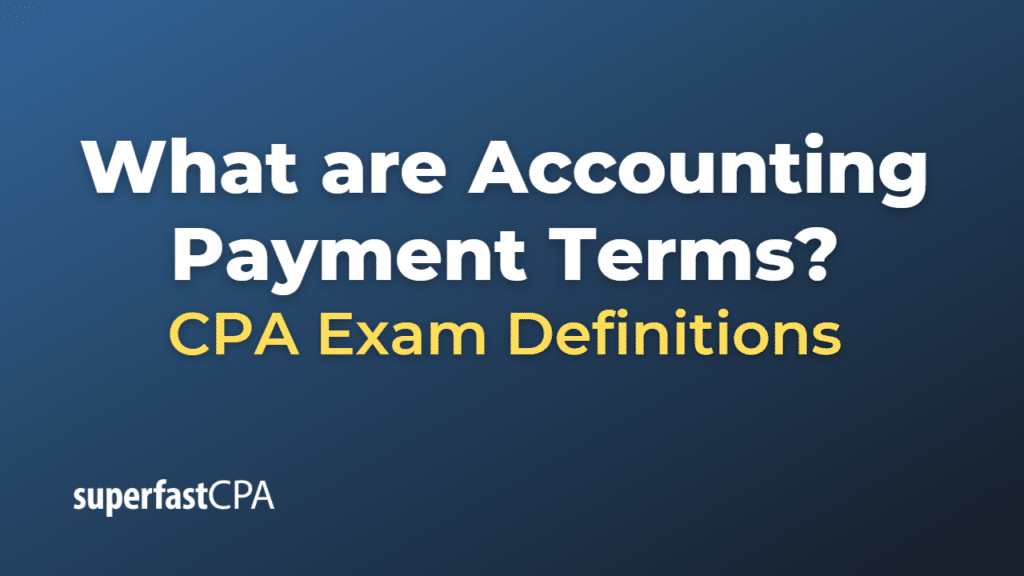Accounting Payment Terms
Accounting payment terms are the conditions and timeframes agreed upon between a buyer and a seller regarding the payment for goods or services. Payment terms are typically included in invoices, contracts, and purchase orders, and they help to manage cash flow, minimize late payments, and clarify the expectations between the parties involved in a transaction.
Some common types of accounting payment terms include:
- Immediate Payment: Payment is due upon receipt of the goods or services, or immediately after the invoice is issued. This payment term is often indicated as “Due Upon Receipt” or “Payable on Receipt” on the invoice.
- Net Terms: The most common payment terms, net terms specify the number of days within which the payment must be made, starting from the invoice date. For example, “Net 30” means the payment is due within 30 days of the invoice date, while “Net 45” indicates that the payment is due within 45 days of the invoice date.
- Discounts for Early Payment: To encourage prompt payment, some sellers offer discounts to buyers who pay their invoices before the due date. For example, a payment term of “2/10, Net 30” means that the buyer can take a 2% discount if they pay the invoice within 10 days; otherwise, the full payment is due within 30 days.
- End of Month (EOM): This payment term indicates that the payment is due by the end of the month in which the invoice is issued. For example, if an invoice is issued on June 10 with the payment term “Net 10 EOM,” the payment is due by July 10 (10 days after the end of June).
- Due on a Specific Date: In some cases, the payment is due on a specific date agreed upon by both parties, regardless of the invoice date. For example, a payment term of “Due on July 15” means that the payment must be made by July 15, regardless of when the invoice was issued.
- Installments: For larger transactions or long-term contracts, the payment terms may include installment plans, where the buyer pays the total amount in smaller, scheduled payments over a specific period.
It is essential for both buyers and sellers to clearly understand and agree on the payment terms before entering into a transaction. Clear communication of payment terms can help to minimize disputes, manage cash flow, and build trust between the parties involved in a business transaction.
Example of Accounting Payment Terms
Let’s consider a hypothetical example involving two businesses, “TechWorld Inc.” and “GadgetStore.” TechWorld Inc. manufactures electronic gadgets, and GadgetStore is a retailer that sells these gadgets to consumers.
GadgetStore places an order with TechWorld Inc. for $10,000 worth of gadgets. TechWorld Inc. sends the shipment along with an invoice that includes the following payment terms: “2/10, Net 30.”
In this example, the payment terms are as follows:
- “2/10” indicates that GadgetStore can take a 2% discount on the total invoice amount if they pay within 10 days of the invoice date. In this case, GadgetStore would pay only $9,800 ($10,000 – $200 discount) if they make the payment within 10 days.
- “Net 30” means that the full payment of $10,000 is due within 30 days of the invoice date if GadgetStore does not take advantage of the early payment discount.
GadgetStore has two options:
Option 1: Pay within 10 days and avail of the 2% discount. In this case, GadgetStore pays $9,800 to TechWorld Inc.
Option 2: Pay the full invoice amount of $10,000 within 30 days.
By offering an early payment discount, TechWorld Inc. encourages GadgetStore to pay the invoice promptly, helping TechWorld to manage its cash flow more effectively. On the other hand, GadgetStore benefits from a discounted payment if it can arrange to pay the invoice early.
This example demonstrates how payment terms can influence the payment behavior of buyers and sellers and help manage cash flow and working capital in business transactions.













